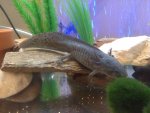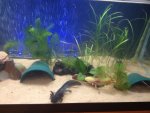Fimbriae
New member
Hello fellow members!
I am trying to collect some data on contributing factors for large feathery gills in axolotls. I know this is a topic that has been heavily discussed, but I am looking for some anecdotal and quantifiable data.
If you keep any axolotls with beautiful gills, please contribute (it would be greatly appreciated! )
)
I've compiled a simplified list of non-genetic related, environmental parameters that I feel have an impact on gill health.
Post a picture of your axie and provide the following information please:
[1] Nitrate levels (in ppm)
[2] General Hardness (in ppm or dGH)
[3] ph
[4] Temperature range
[5] Approximate age of Axolotl
[6] Diet of Axolotl
[7] Type of filtration
[8] Type of filter output (ex. Spraybar)
[9] Type of media in filter
[10] Amount of surface agitation (subjective, I know )
)
[11] Pump with Airstone - yes/no?
[12] Live plants - yes/no?
[13] Substrate/Barebottom?
[14] Tank dimensions and water depth
I know this is asking a lot, but I think this information may be helpful to others as well.
Thank you everyone, I look forward to your input and pictures!
I am trying to collect some data on contributing factors for large feathery gills in axolotls. I know this is a topic that has been heavily discussed, but I am looking for some anecdotal and quantifiable data.
If you keep any axolotls with beautiful gills, please contribute (it would be greatly appreciated!
I've compiled a simplified list of non-genetic related, environmental parameters that I feel have an impact on gill health.
Post a picture of your axie and provide the following information please:
[1] Nitrate levels (in ppm)
[2] General Hardness (in ppm or dGH)
[3] ph
[4] Temperature range
[5] Approximate age of Axolotl
[6] Diet of Axolotl
[7] Type of filtration
[8] Type of filter output (ex. Spraybar)
[9] Type of media in filter
[10] Amount of surface agitation (subjective, I know
[11] Pump with Airstone - yes/no?
[12] Live plants - yes/no?
[13] Substrate/Barebottom?
[14] Tank dimensions and water depth
I know this is asking a lot, but I think this information may be helpful to others as well.
Thank you everyone, I look forward to your input and pictures!





